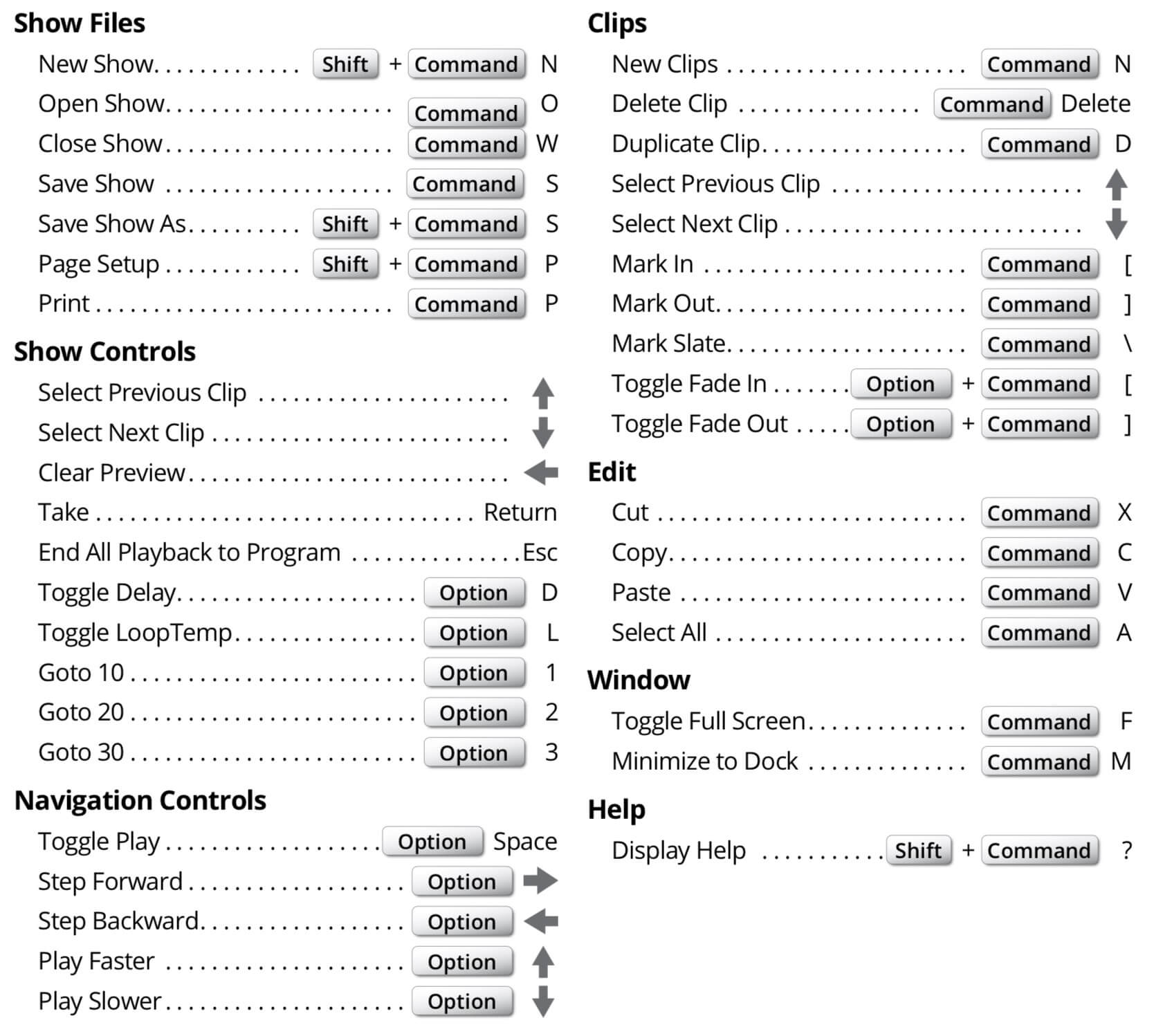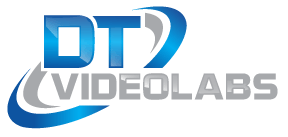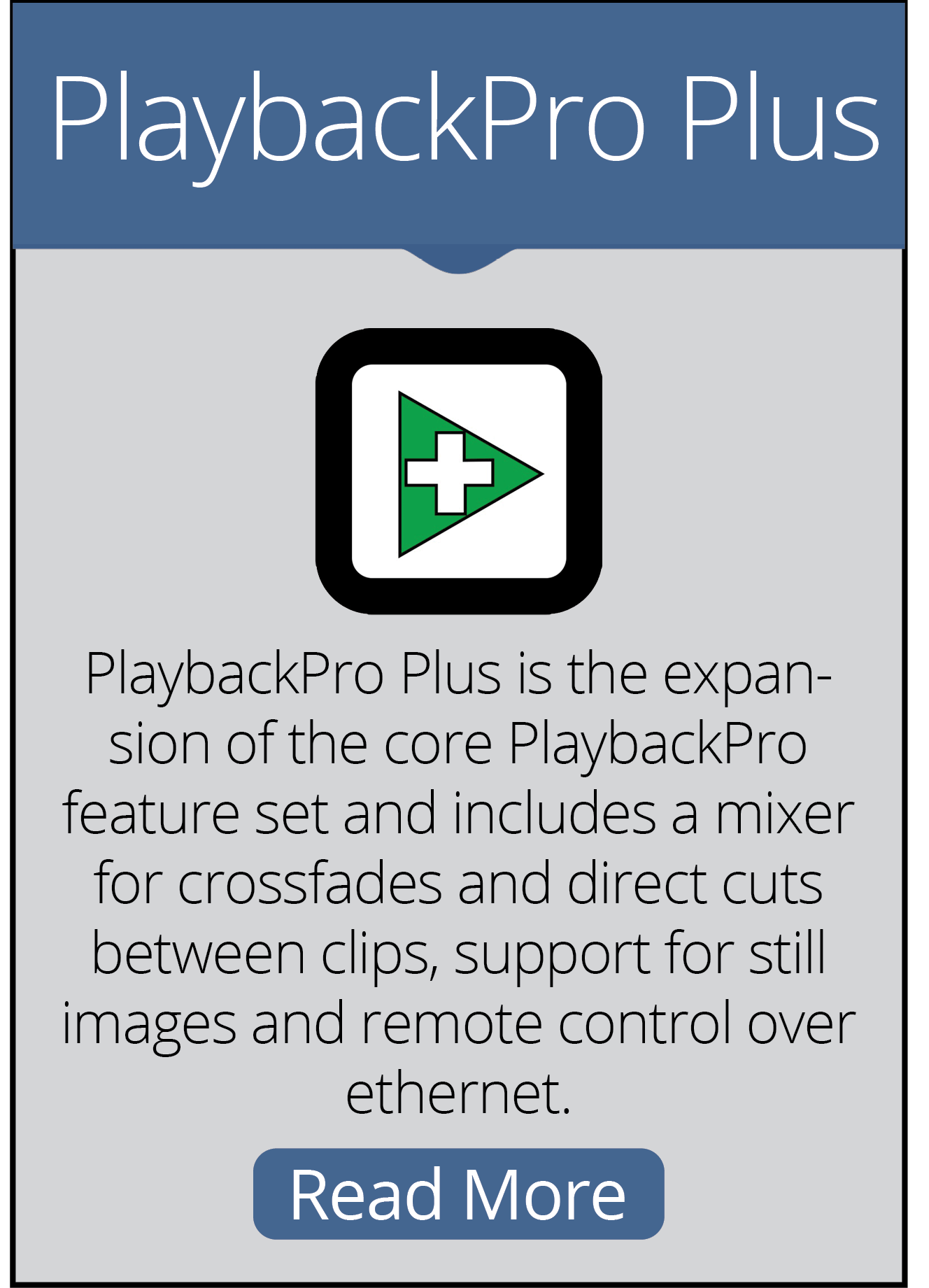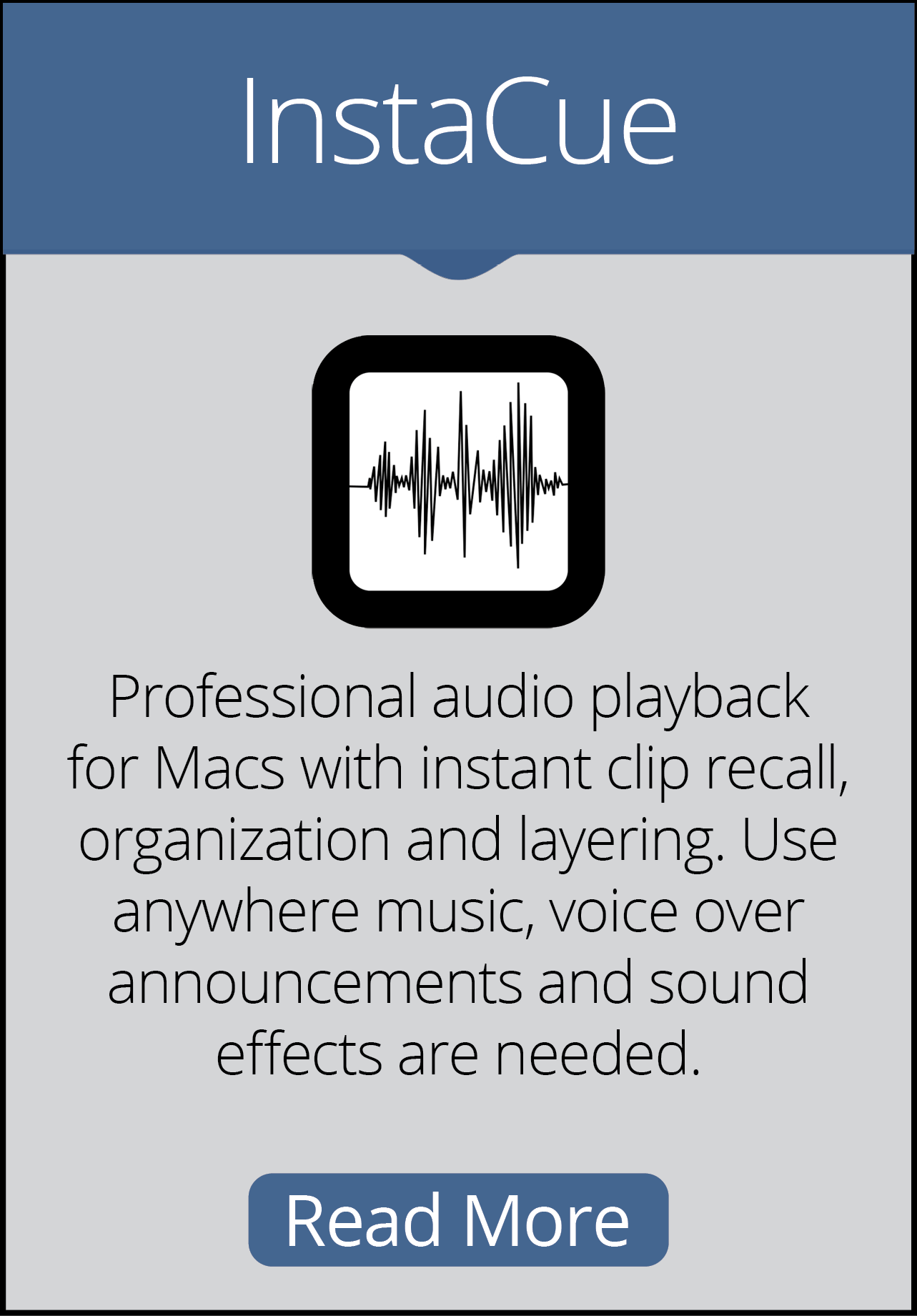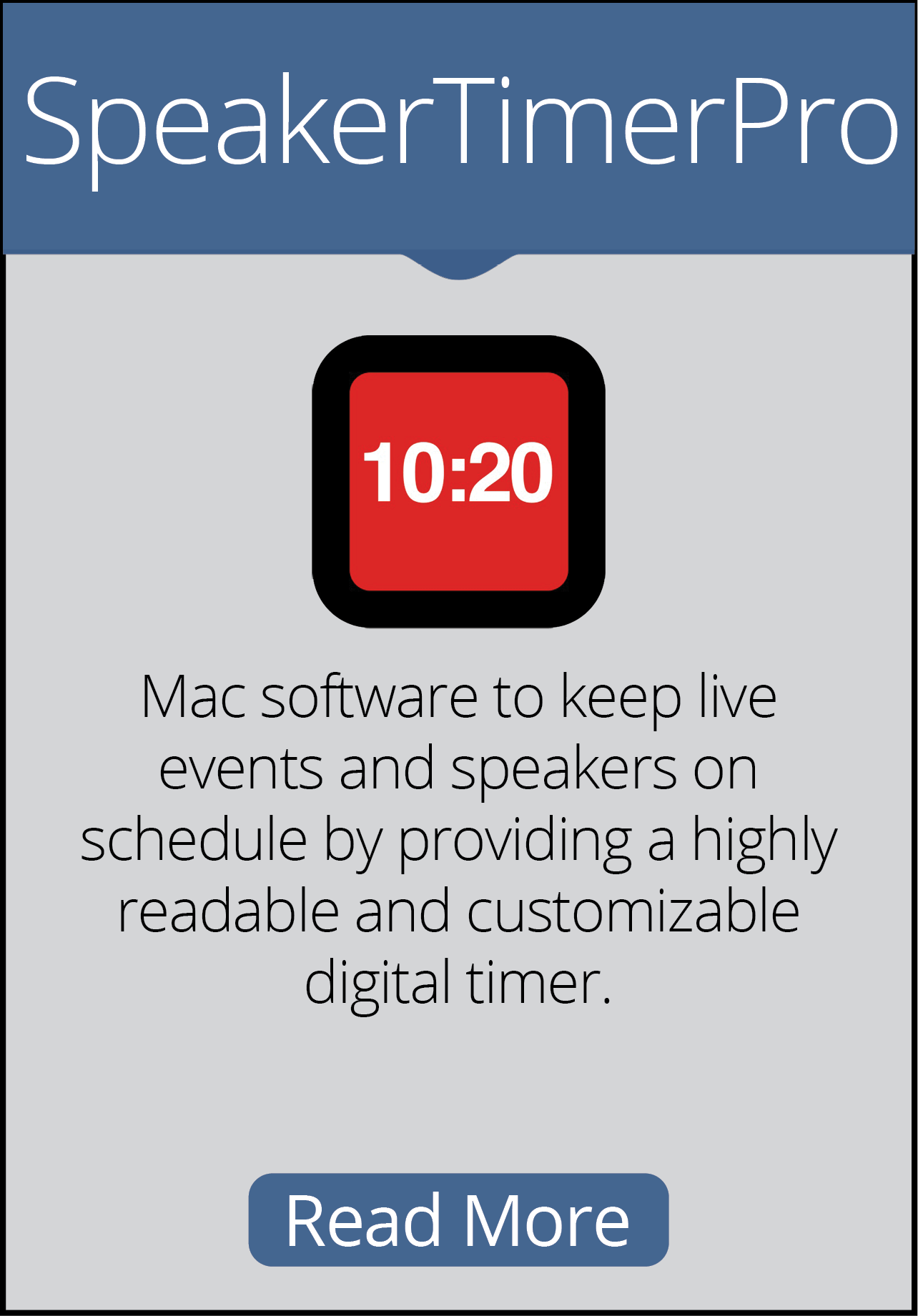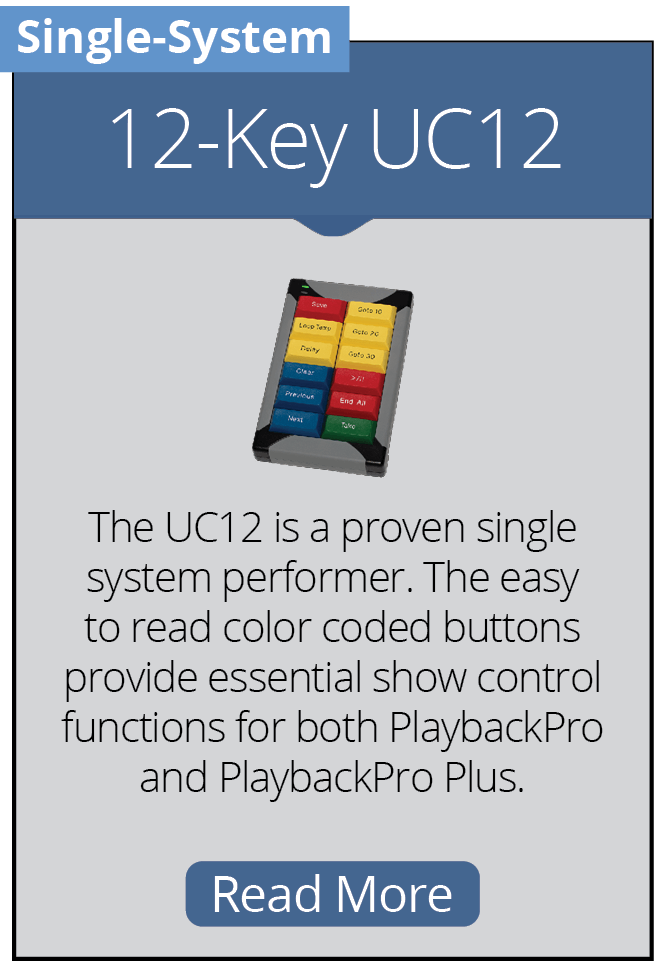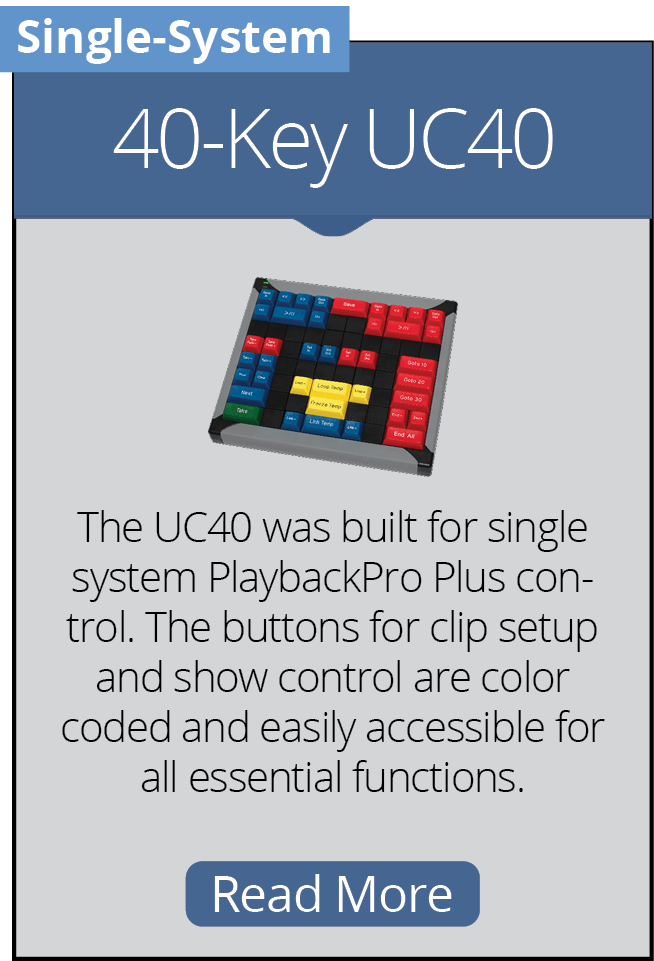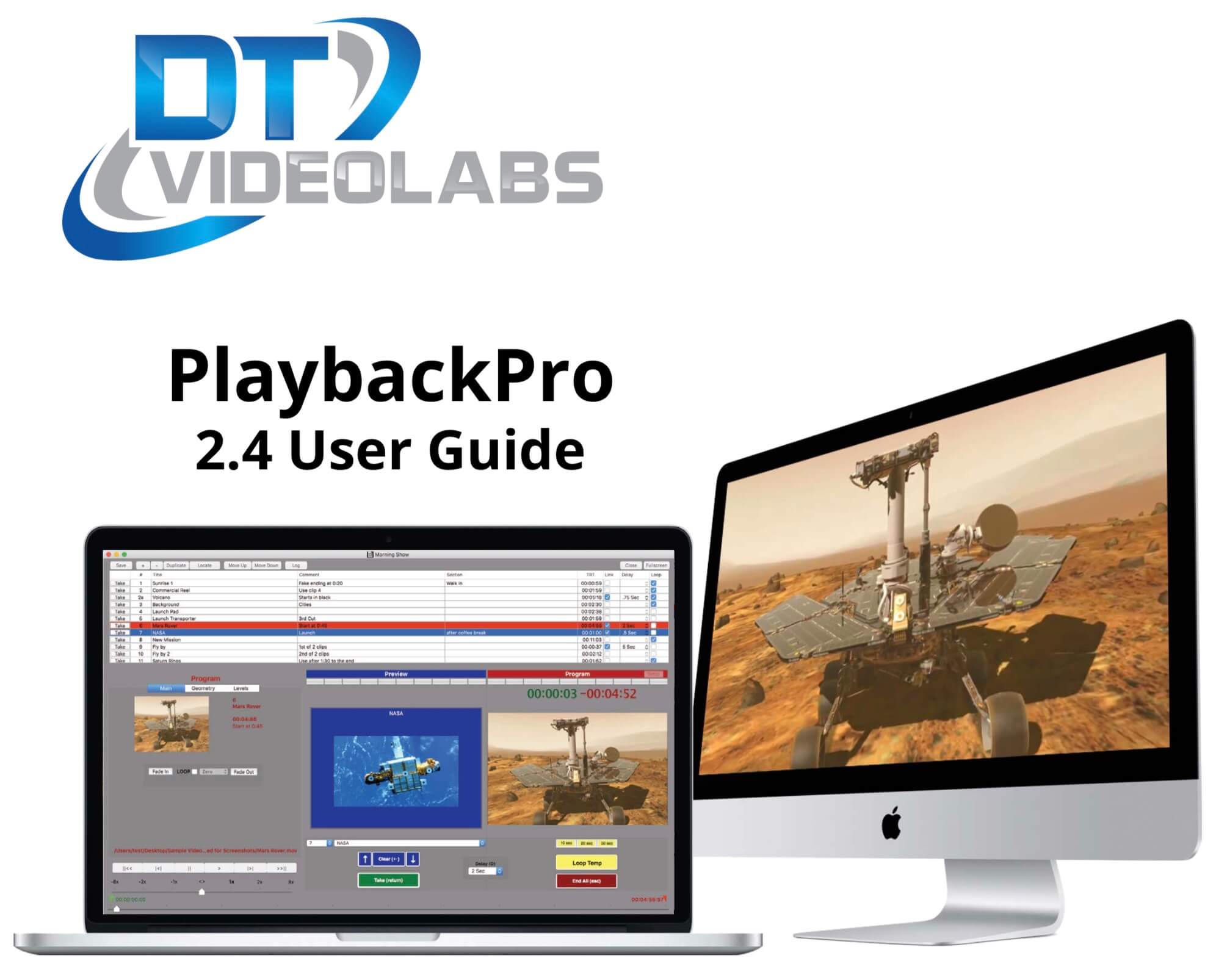
About PlaybackPro
PlaybackPro is designed to make professional media playback on a Mac quick and simple. Utilizing the best in Apple video technology, PlaybackPro has been optimized to play virtually any modern Mac file type. The intuitive interface allows you to rapidly add media, organize and play clips, apply custom settings and save playlists, all without altering the original files.
Automatic output resolution and aspect ratio functions are built-in, with real-time manual adjustments available for sizing, stretching, cropping, as well as gain, saturation, black levels and volume.
Connecting a PlaybackPro Plus system is easy too. By using modern Apple video adapters or third party broadcast converters, PlaybackPro Plus easily connects to professional switchers, video projectors, LED video walls and high-resolution monitors. PlaybackPro is not currently compatible with video output devices such as an Aja T-TAP or Blackmagic UltraStudio device. Please visit our www.dtvideolabs.com/faq for current information.
Table of Contents

Before You Begin

PreFlight
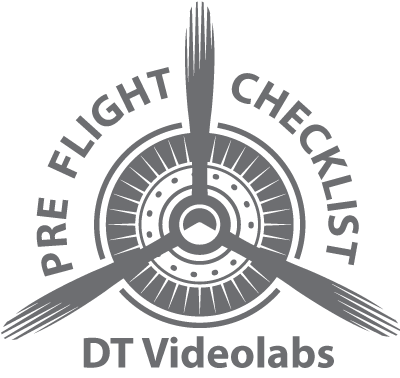
Each version of macOS has specific settings which have a great impact on playback performance. Before you begin, please visit www.dtvideolabs.com/preflight.This page also includes a link to a printable PDF if needed.

System Specifications
Using the right Mac system, configured with recommended codecs and container files is key to successful high resolution playback with PlaybackPro Plus. Please visit www.dtvideolabs.com/system-recommendations for the most current specifications and Mac system recommendations.

Setup

General Hardware Setup
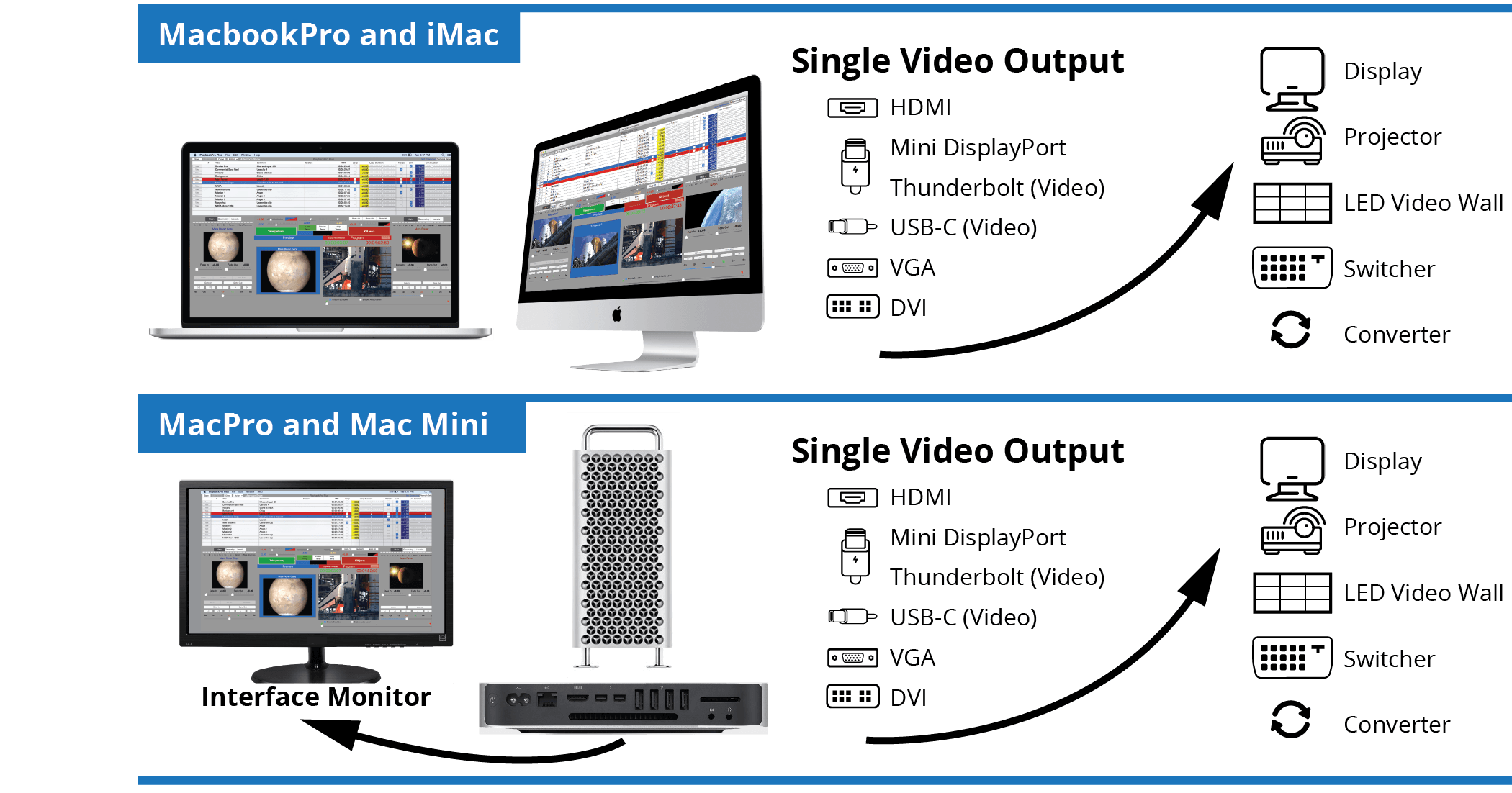

License Activation
Activating an Internet Activated (IA) Serial Number
PlaybackPro can be activated using a serial code from either PlaybackPro, PlaybackPro Plus or the PlaybackPro Collection.
- Download the PlaybackPro IA application from the link provided in your purchase email or from the Internet Activated (IA) table on www.dtvideolabs.com/downloads
- Place the unzipped program file into the Applications folder then double click to launch.
A delay of up to 10 seconds can occur when launching the application. This is normal behavior as the application checks the license. - In the dialog box click the “Activate” button under the name of the application to be activated
- Enter the serial number provided at the time of purchase, including the dashes. A DT Videolabs serial number will always be 4 sets of 8 digits, separated by dashes. For example, xxxxxxxx-xxxxxxxx-xxxxxxxx-xxxxxxxx. Enter your personal registration information in the remaining fields and click “Activate Now”. It is important that you enter something in each of the fields.
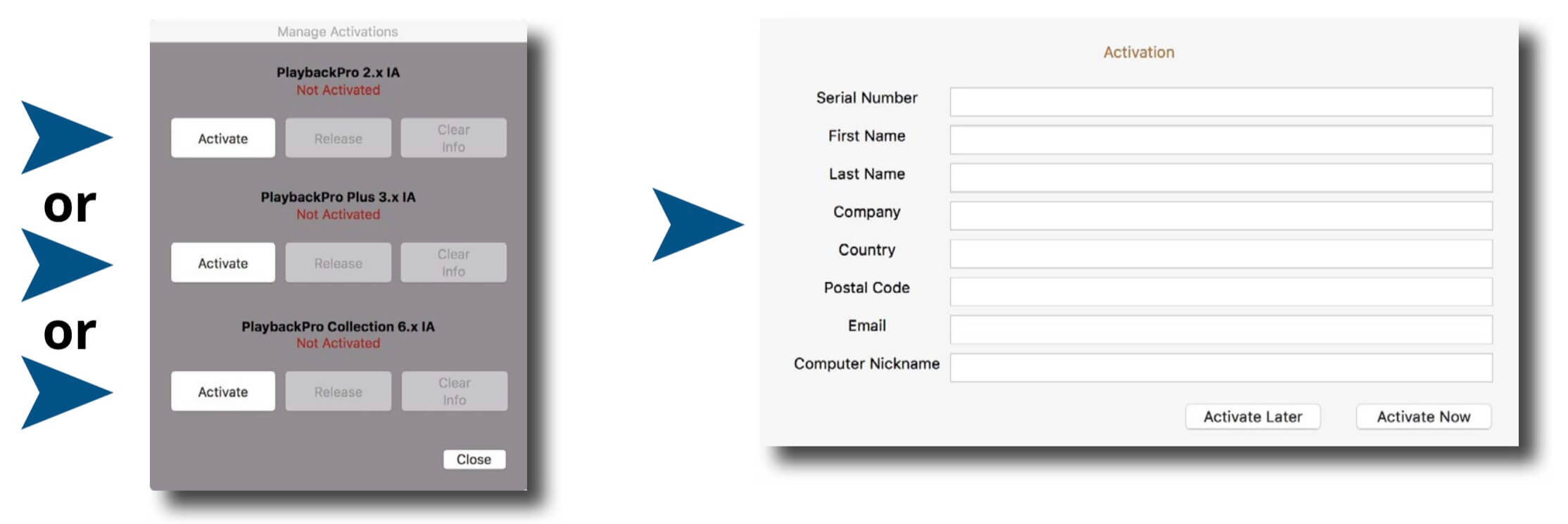
Notes
Internet access is required to activate or release a license, however it is not necessary for program use once a license is activated
- Registration information can be unique each time an application is activated
- Licenses are single seat and allow for the use of one application at a time, on one computer at a time
- License may be released from one computer and moved to another using the release process outlined below and at www.dtvideolabs.com/activation
Once activated, the Application Control Window will appear. If you encounter any problems during activation, please visit www.dtvideolabs.com/contact or email technical@dtvideolabs.com.
Releasing an Internet Activated Serial Number
Connect the computer to the internet
- Launch PlaybackPro
- Go to the PlaybackPro menu (to the left of the File Menu), select “Manage Licenses”
- Store the serial number. A DT Videolabs serial number will always be 4 sets of 8 digits with dashes in-between.
- Click on “Release License”. The system will report when the license has been successfully released and available to activate on another system.
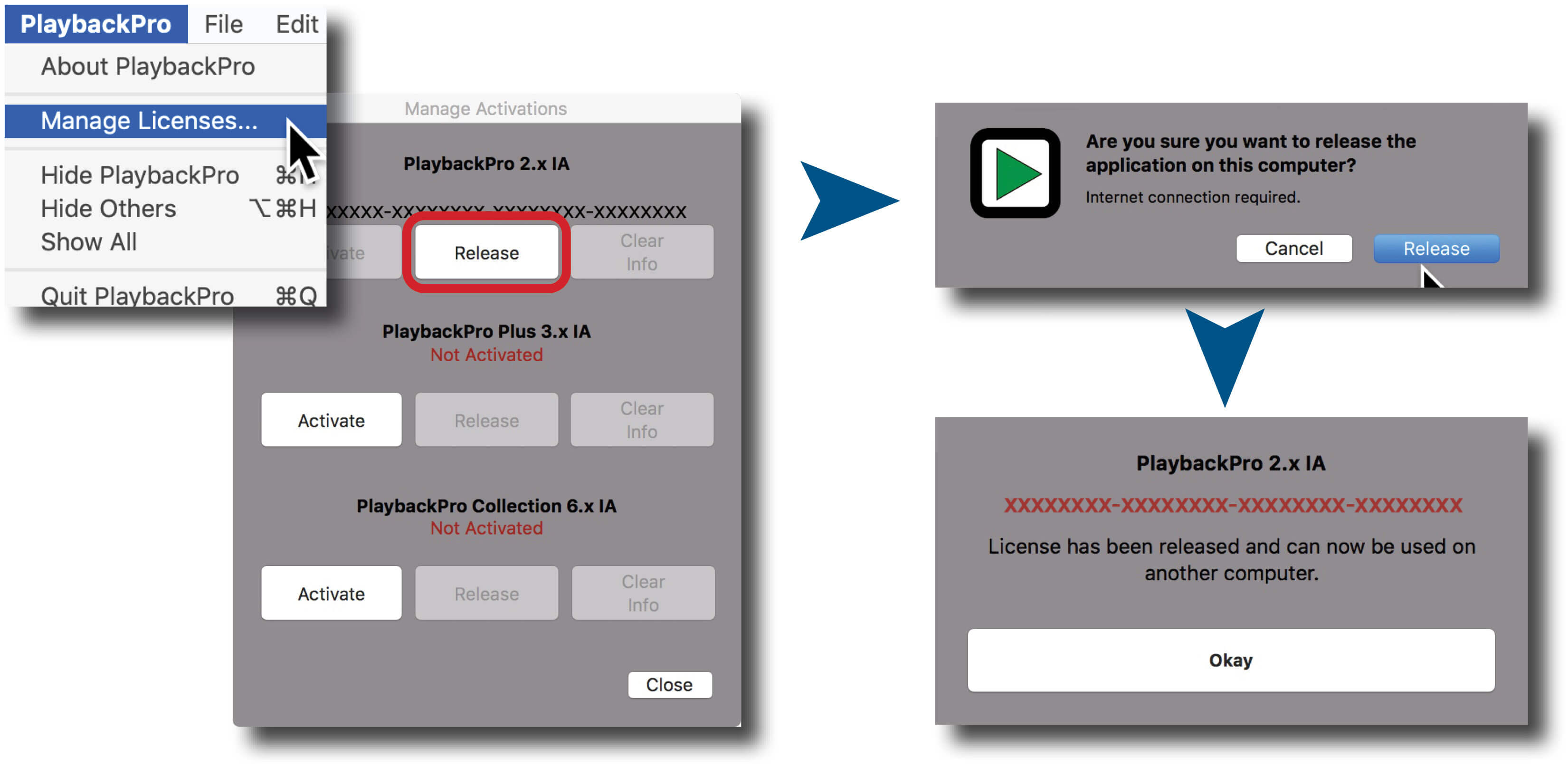
***IMPORTANT*** License information will be retained on your system after you release a license. Users of previous versions will notice the addition of the “Clear Info” button which removes previous license info from your system and can aid in troubleshooting. If you have trouble activating a license, clear the info and try activating again. If you use the “Clear Info” button, it is important for you to retain a copy of your license number so you can reactivate.
New USB Installation Collection Instructions
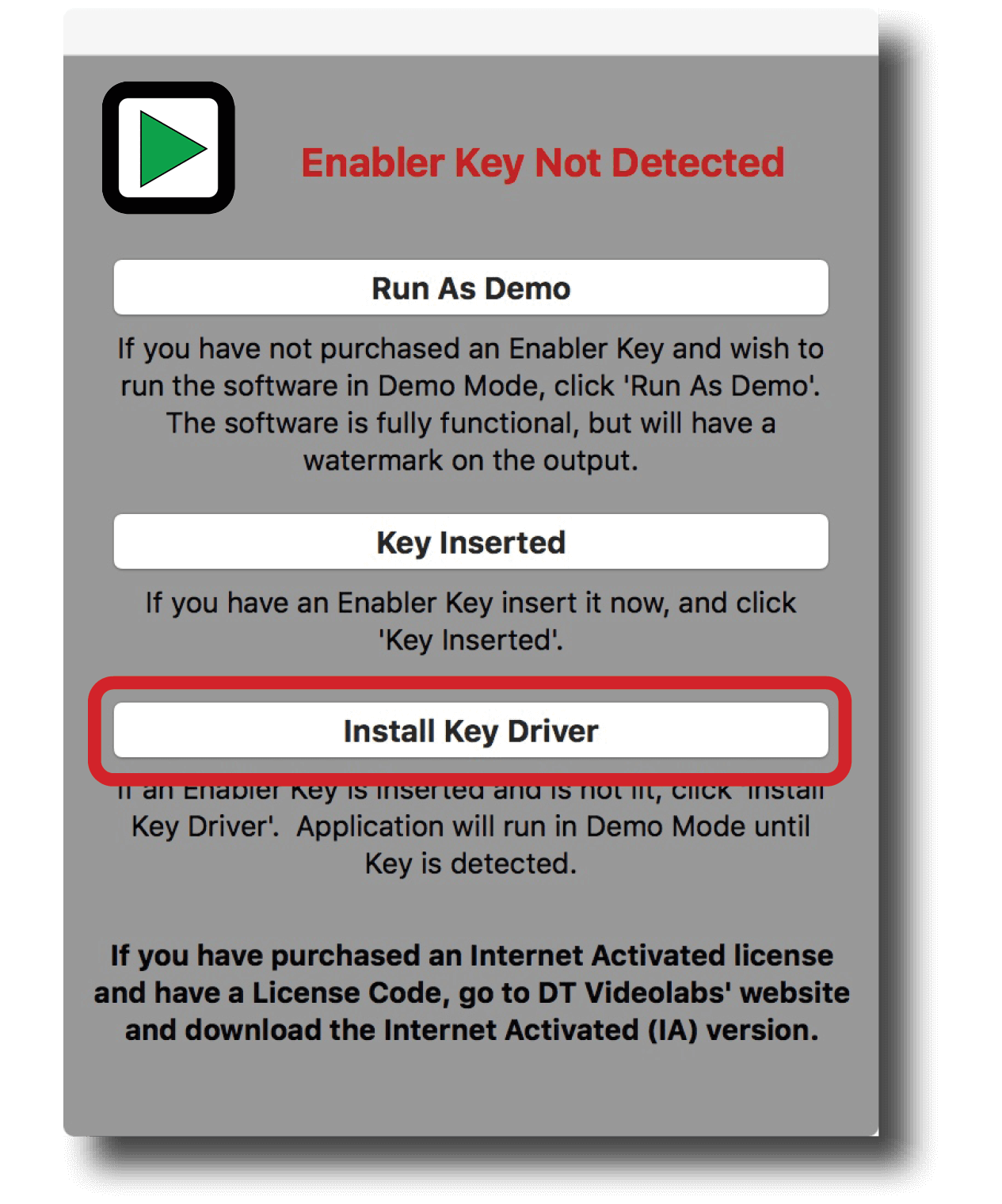
Connect the computer to the internet
- Insert the USB Enabler key into the system
- If you haven’t already, go to www.dtvideolabs.com/downloads to download the Collection
- Place the unzipped program files into the Applications folder then double click an application to launch
- If running an application on a system for the first time, a window will open after you attempt to create or open a show. Select “Install Key Driver”and follow the on-screen instructions
***IMPORTANT*** License information will be retained on your system after you release a license. Users of previous versions will notice the addition of the “Clear Info” button which removes previous license info from your system and can aid in troubleshooting. If you have trouble activating a license, clear the info and try activating again. If you use the “Clear Info” button, it is important for you to retain a copy of your license number so you can reactivate.

Demo Mode
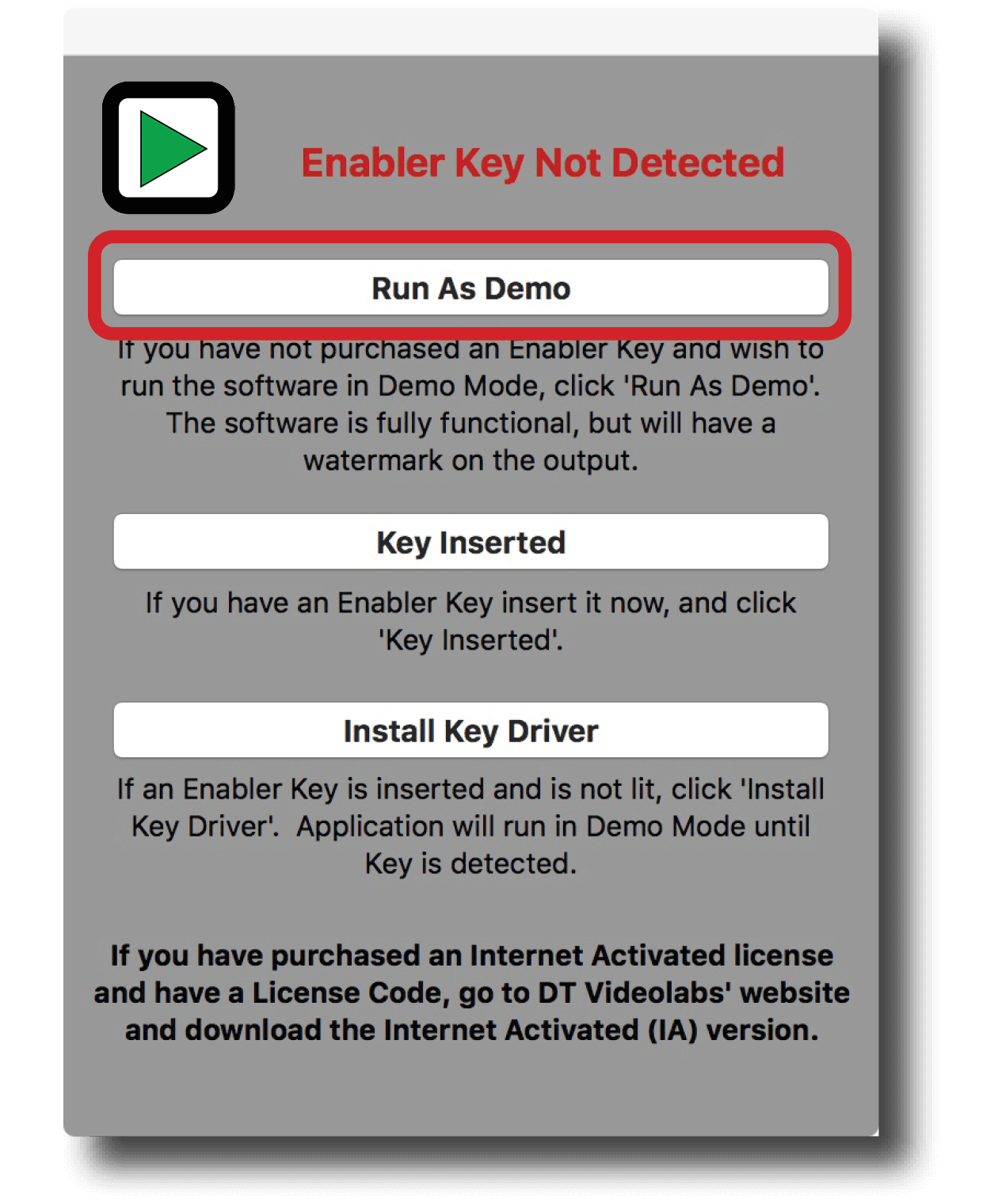
If you need to evaluate PlaybackPro or set up a show off-line, you can use Demo mode. It is fully functional but has a watermark on the fullscreen output. Download the USB version of PlaybackPro (Internet Activated versions do not offer a demo mode) from www.dtvideolabs.com/downloads, launch it, click on “New Show.” After a few moments, you will get a dialog box with options for the USB key. Select “Run as Demo.”

Top Keyboard Commands
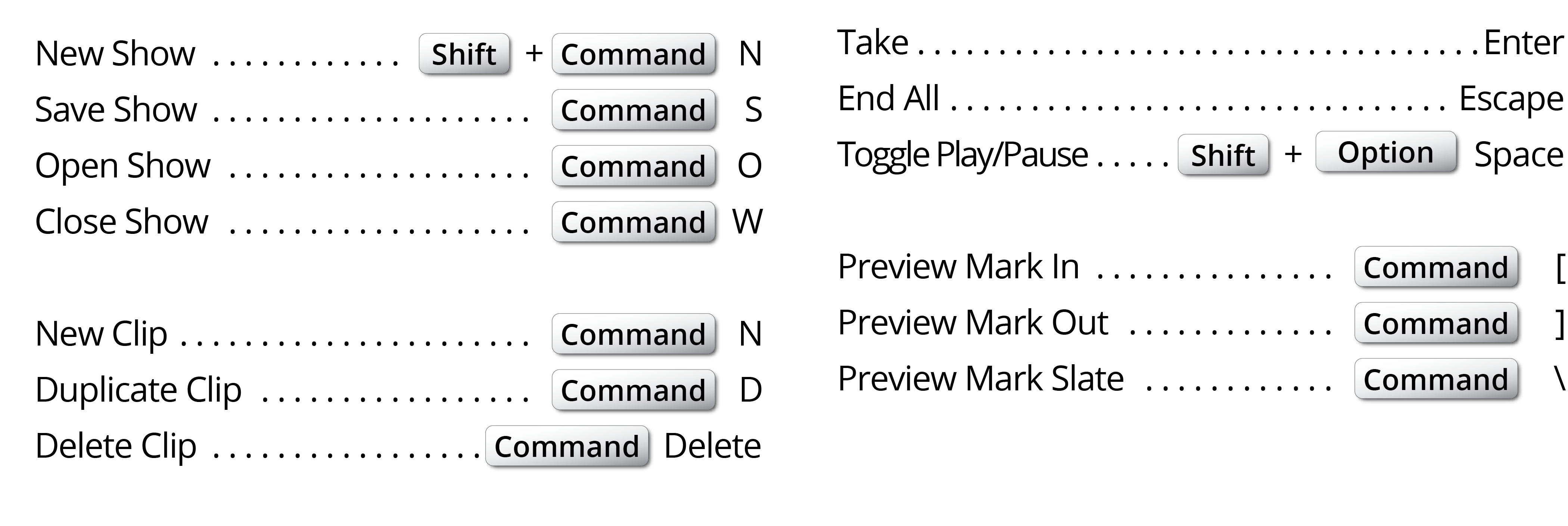

Audio
Currently audio is handled by macOS. To change the audio output go to System Preferences, Sound, Output. Multi-channel audio is possible with PlaybackPro. Please contact us for current instructions.
Common compatible codecs are AAC, AIFF/AIFC, MP3 and .WAV.

Interface

Layout
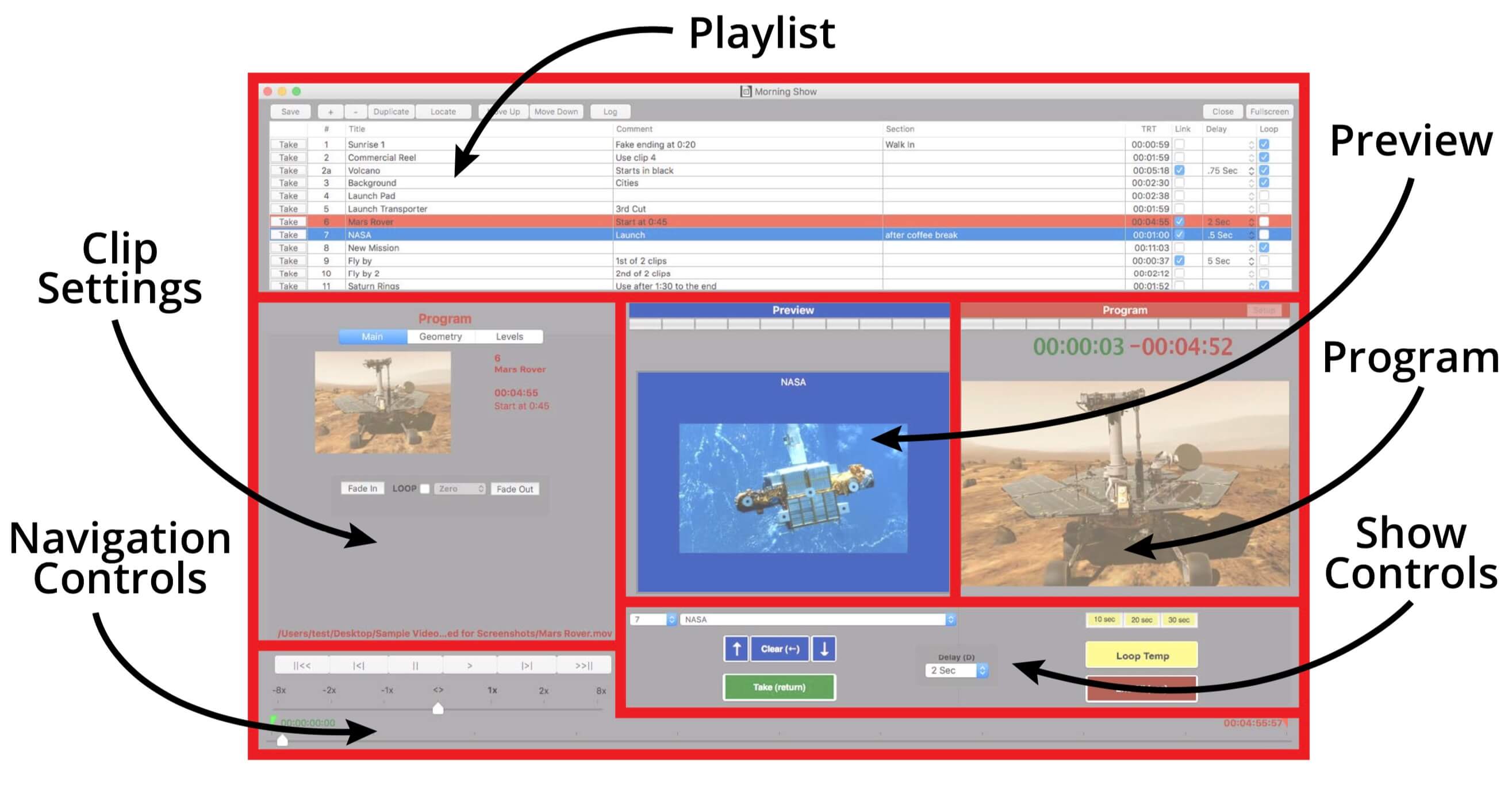

Preview / Program
PlaybackPro is designed on a Preview/Program paradigm, similar to a production switcher.
Preview - Preview is what will play next. Preview is always in blue. When a clip is selected from the playlist, it is placed in Preview and will automatically transition to Program when a Program clip ends. Preview is used to set in/out points, set levels, fades and geometry.
Program - Program is what’s going to the output. Program is always in red. When a clip is Taken from Preview, it transitions to Program and plays with any attributes you’ve set (in/out Points, fades, geometry, levels, etc). The Program window shows the clip exactly as it appears on the external output. When a clip in Program ends, whatever is in Preview will automatically transition to Program, known as a roll-through.
Green counter - The green counter is located over the Preview and Program window and shows the time elapsed relative to the In Point.
Red counter - The red counter is located over the Preview and Program window and shows the time remaining relative to the Out Point.
Setup - The aspect ratio of the output is reflected in the Preview and Program sections. To change the output resolution use the “Setup” button in the red Program area and select the desired resolution.

Playlist
The clips are shown in the Playlist and attributes are applied as clips are played. The clips are only being referenced, PlaybackPro is nondestructive to original clips.

Adding Clips
- “File” menu and select “New Clips”
- “Action” button and select “New Clips”
- Press COMMAND + N
- Drag and drop from a Finder window
Removing Clips
- “File” menu and select “Remove Clip”
- Highlight clip and press COMMAND + Delete
- “Action” button, select “Edit Multiple”, select clips, select “Delete Selected”
Duplicating Clips
- Highlight clip and select “File” and “Duplicate”
- Highlight clip and select “Action” and “Duplicate”
- Highlight clip and press COMMAND + D
- Duplicated clips create a new clip entry in the playlist but do not create a new file on a hard drive.
Ordering Clips
Clips can be reordered by dragging and dropping, or by using the “Move Up” and “Move Down” options from the “Action” button.
Locating Clips
If a clip has been moved from its original location or is off-line, its text will be grayed out. By clicking the “Action” button and selecting “Locate” you can redirect the reference to its new location, however the clip must have the same name.
Playlist Fields
# Field - Enter alpha numeric text to help organize clips. The clip number field is for operator convenience, and does not affect the order in which the clips are played.
Title - Allows you to rename the reference of the clip for easier selection. Changing the title in this field does not change the filename of the original file stored on a hard drive.
Comment - Enter text / production notes for the clip
Section - Enter text / production notes for the clip
TRT - Total runtime of the clip
Link - When checked, the next clip in the playlist will automatically load into Preview and will automatically transition to Program after the current clip completes plaback
Delay - A delay (black screen) between clips can be set with a range of .25 seconds to 5 seconds
Loop - Select to loop an individual clip. When playback begins for a clip which is set to loop, the “Loop Temp” button in Show Controls is activated. See page 13 for more information on Show Controls. An entire playlist may be looped by selecting the “Link” checkbox for each clip.
Log
Log is designed to track the number of times a clip is played during a PlaybackPro session. This is helpful for live events where advertisers pay based on the number of times an ad is played.
Print Playlist
The playlist can easily be printed or saved as a PDF file by using the File menu and selecting Print.
Clips can be reordered by dragging and dropping, or by using the “Move Up” and “Move Down” options from the “Action” button.
If a clip has been moved from its original location or is off-line, its text will be grayed out. By clicking the “Action” button and selecting “Locate” you can redirect the reference to its new location, however the clip must have the same name.
# Field - Enter alpha numeric text to help organize clips. The clip number field is for operator convenience, and does not affect the order in which the clips are played.
Title - Allows you to rename the reference of the clip for easier selection. Changing the title in this field does not change the filename of the original file stored on a hard drive.
Comment - Enter text / production notes for the clip
Section - Enter text / production notes for the clip
TRT - Total runtime of the clip
Link - When checked, the next clip in the playlist will automatically load into Preview and will automatically transition to Program after the current clip completes plaback
Delay - A delay (black screen) between clips can be set with a range of .25 seconds to 5 seconds
Loop - Select to loop an individual clip. When playback begins for a clip which is set to loop, the “Loop Temp” button in Show Controls is activated. See page 13 for more information on Show Controls. An entire playlist may be looped by selecting the “Link” checkbox for each clip.
Log is designed to track the number of times a clip is played during a PlaybackPro session. This is helpful for live events where advertisers pay based on the number of times an ad is played.
The playlist can easily be printed or saved as a PDF file by using the File menu and selecting Print.

Navigation Controls
Navigation Controls are used for finding specific parts of a clip to set the In and Out points and the Slate image. Although they control the clip while in Program, they are primarily used to set up a clip in Preview.
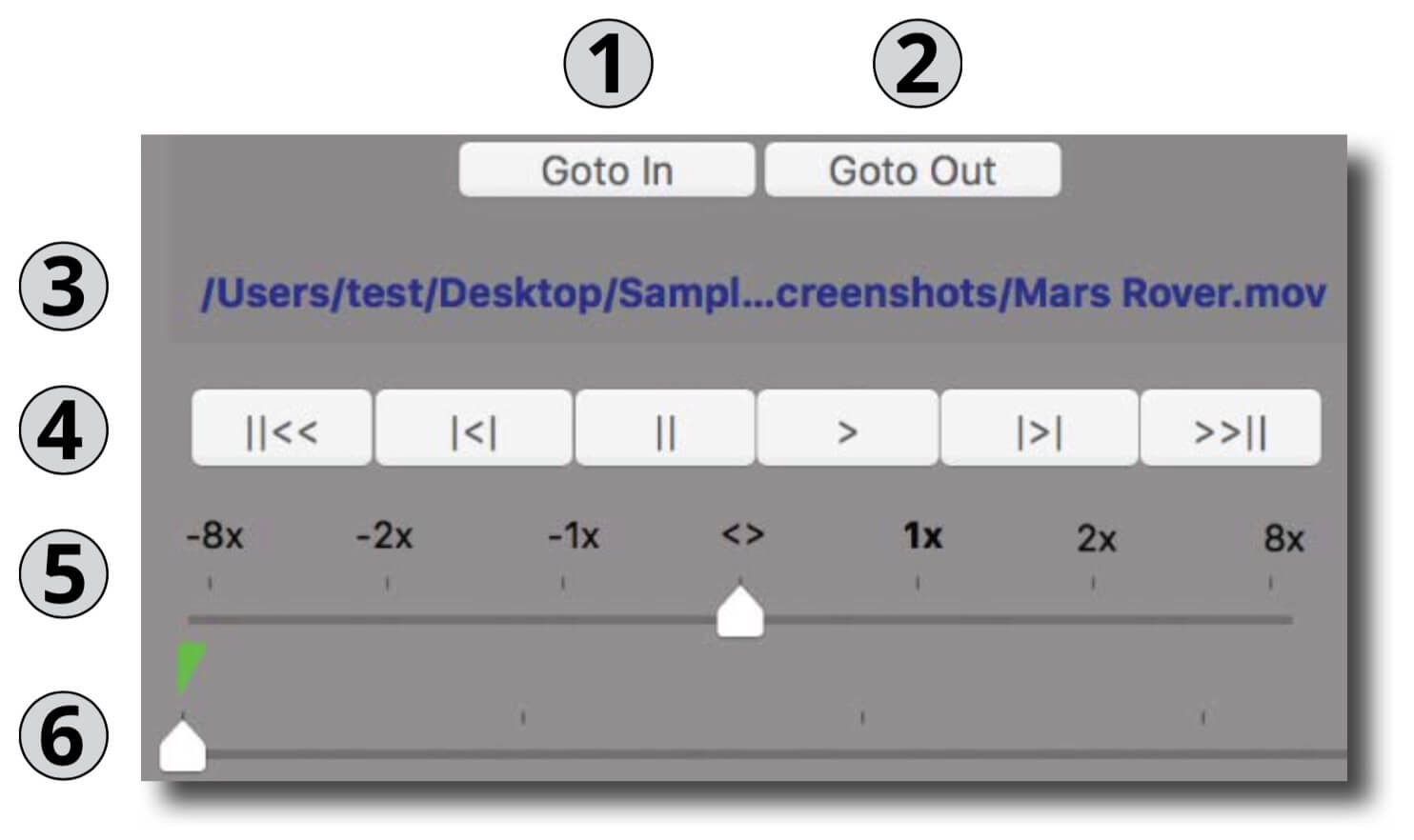
- Goto In - Moves the playback position to the In point
- Goto Out - Moves the playback position to the Out point
- File Path Indicator - Shows the path and name of the referenced file
- Control Buttons - Fast Reverse, Step backward by frame, Pause, Play, Step Forward by frame and Fast Forward (in order from left to right)
- Shuttle - Temporarily changes the playback speed. Primarily used to set up a clip in Preview, however it can be used in Program. Clips in Program always begin playback at normal speed.
- Scrubber - Used to quickly find specific parts of a clip so that In, Out, and Slates can be set. This is primarily used in Preview, however, it can be used while in Program. When a Preview clip is Taken to Program, it starts from its In Point regardless of the Scrubber Position.

Functions

Clip Settings
The clip settings are found on the Preview side and determine how a clip appears in Program. Clip settings only affect the selected clip, whether in Preview or Program. All settings are saved when the playlist is saved.
Main Tab
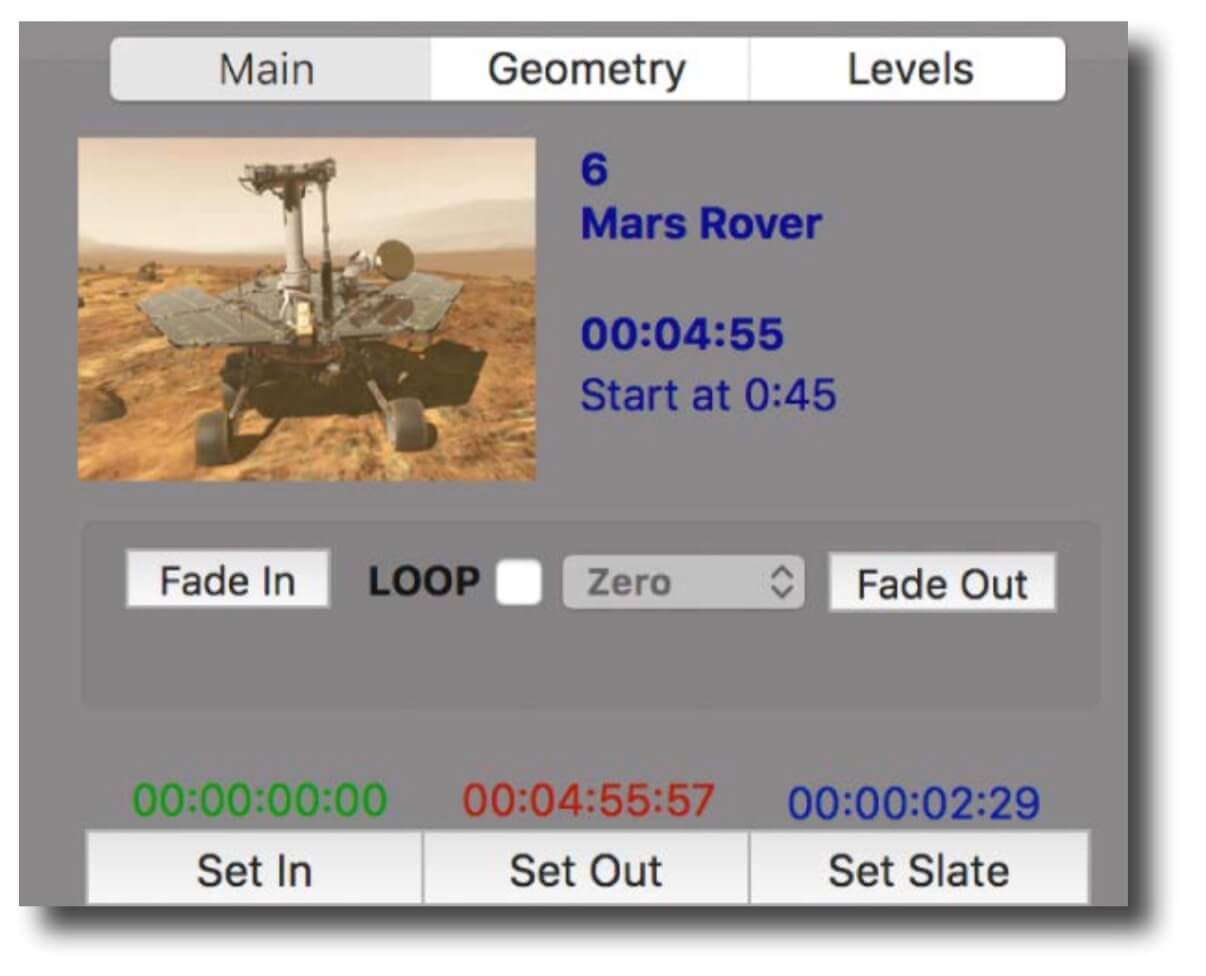

Fade In - Tells clip to Fade-In on start
Fade Out - Tells clip to Fade-Out on end
Loop - Changes the time that will elapse between loops. For additional looping and fading controls see Looping and Fading in section 4.3.
Fade In Each - Tells clip how long to Fade-In on Take
Fade Out Each - Tells clip how long to Fade-Out at end
Set In - Sets where clip will begin playback
Set Out - Sets where clip will end playback
Set Slate - Used to set the Slate image for that clip
Geometry
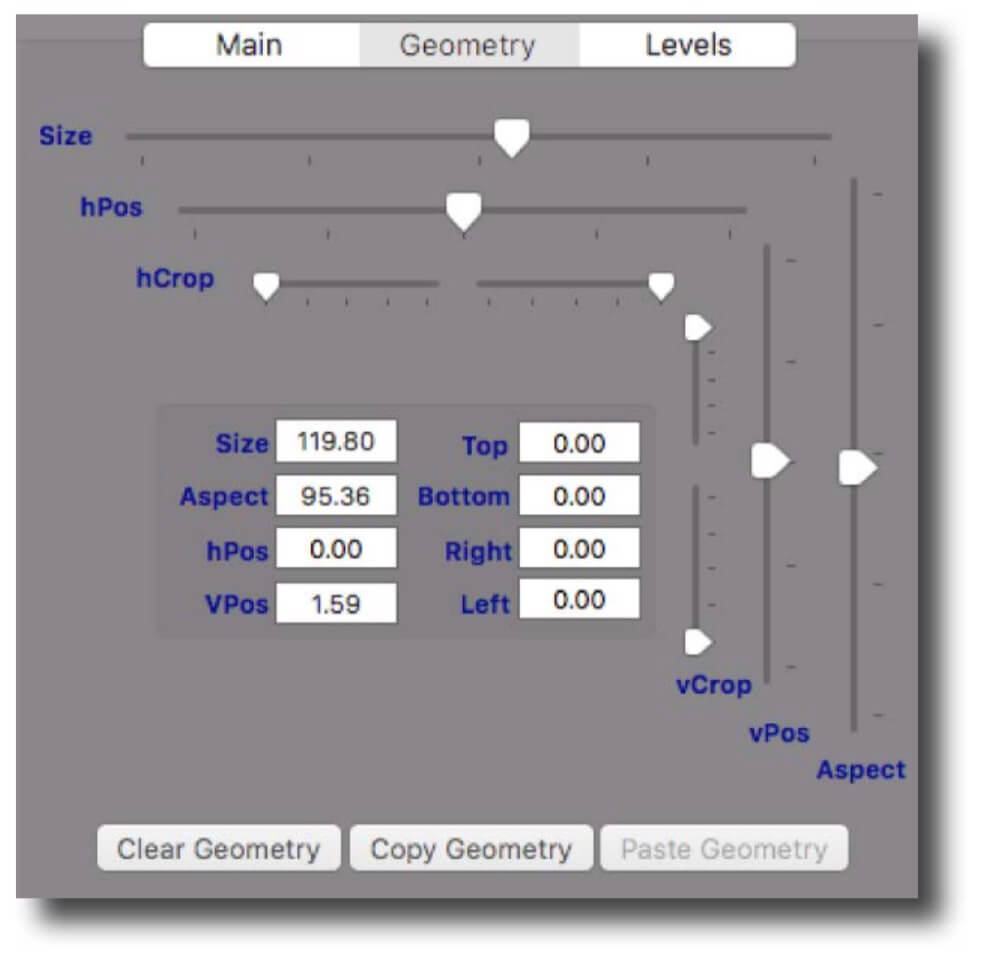
Geometry settings are available on the Preview side to control the size, aspect ratio, cropping and positioning of clips. If a clip is in Program, changes are seen on the video output, as well as in the Program section.
Geometry settings can be copied and pasted between clips using the “Copy Geometry” and “Paste Geometry” buttons.
Levels
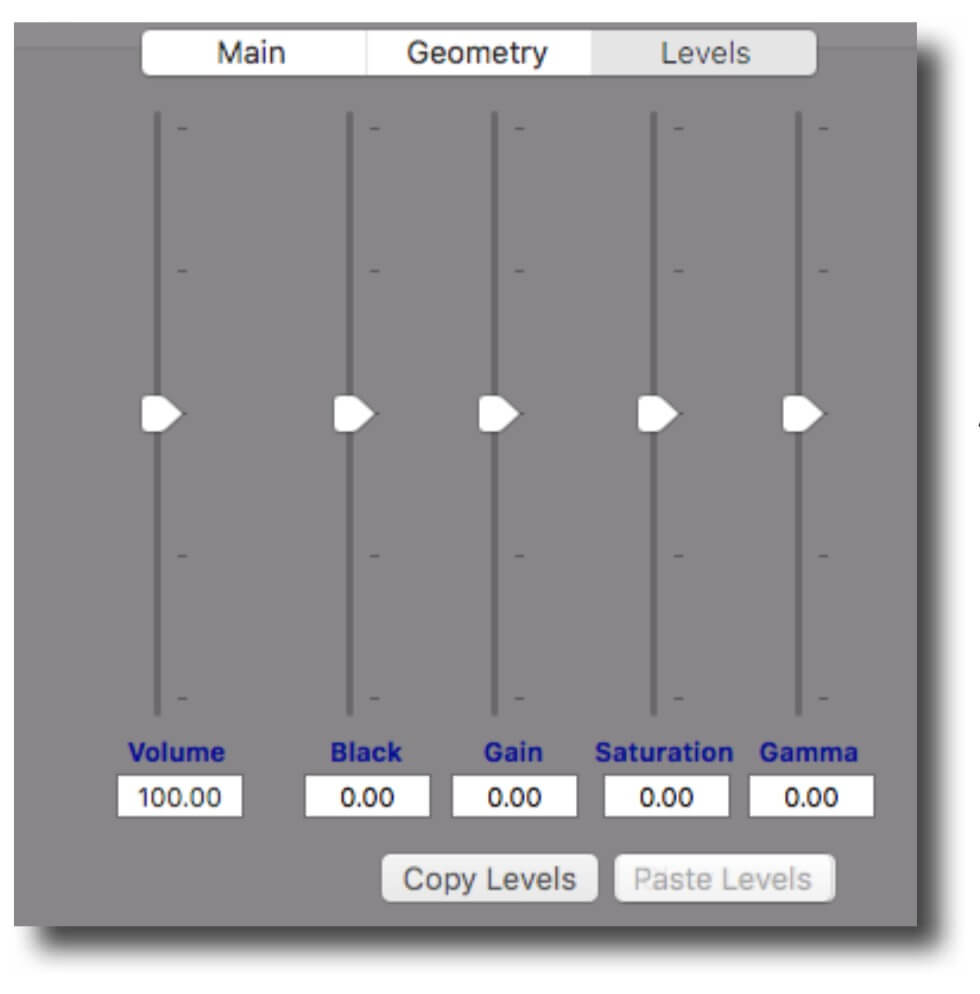
Levels affect the black level, gain, gamma, color, and volume of the current clip. If a clip is in Program, changes are seen on the video output as well as in the Program section.
Levels can be copied and pasted between clips using the “Copy Levels” and “Paste Levels” buttons.

Show Controls and Clip Transitions
The Show Controls breakdown into 2 areas: Take and End All. They are not saved in the playlist and have no permanent effect on a clip.
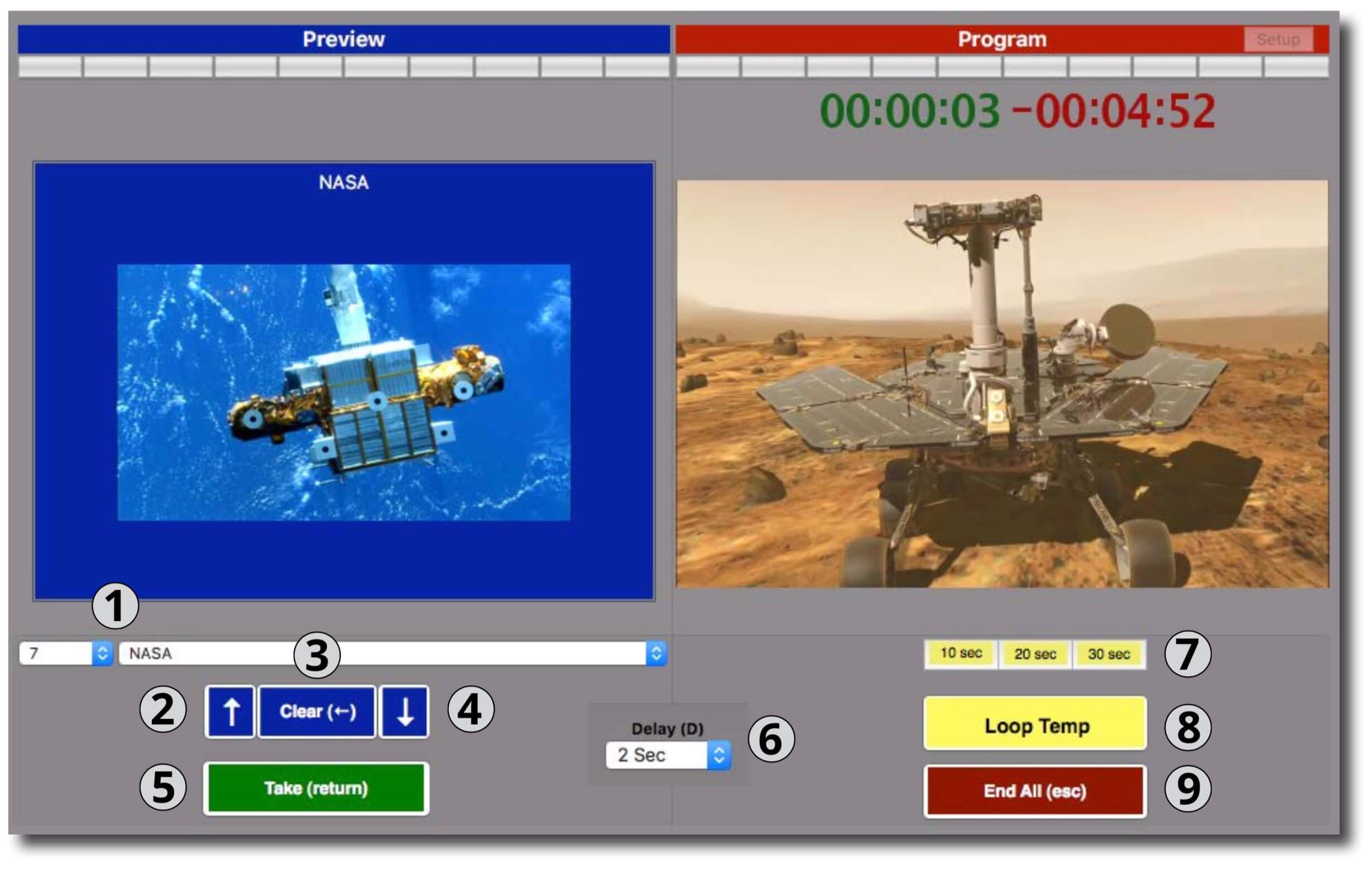
- Quick Select - Allows you to select a clip by number or name
- Select Previous - Selects the Previous clip in playlist
- Clear - Clears the clip loaded in Preview
- Select Next - Selects the Next clip in playlist
- Take - Takes Preview clip to Program
- Delay - Changes the amount of time that will elapse between Preview and Program clip
- Goto Buttons - Sets the Playback position to 10, 20 or 30 seconds from the Out Point
- Loop Temp - Temporarily Loops or Un-loops the Program clip. Click “End All (esc)” to immediately end a loop, or Take if a clip is loaded in Preview. This does not affect the clip’s permanent Loop setting.
- End All (esc) - The audio and video of the Program clip will fade, and the clip loaded in Preview will not play

Looping and Fading
PlaybackPro gives you advanced control over looping and fading. The “Fade In Each” and “Fade Out Each” buttons are only visible when Loop is selected. To end a loop while in Program, click “Loop Temp” in Show Controls. It’s best to experiment with these controls to master them. Here are a few typical examples:
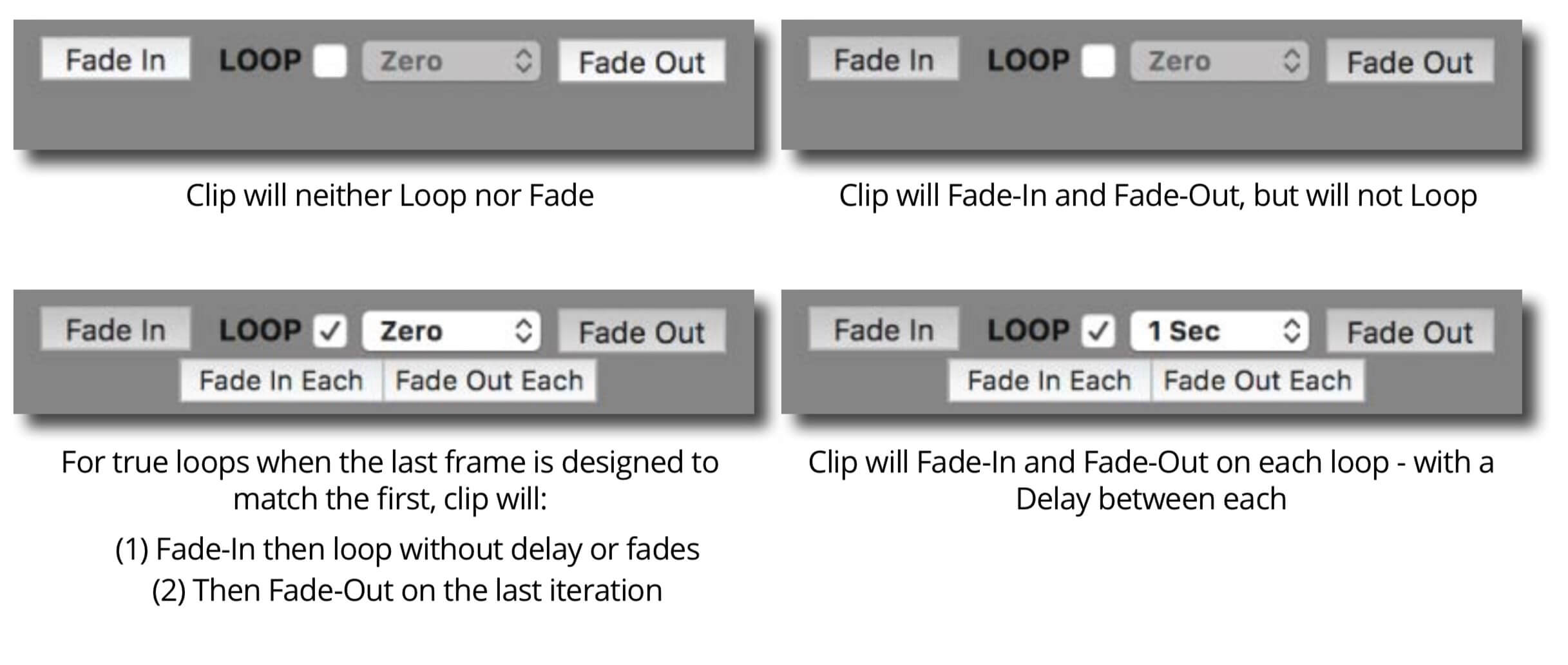
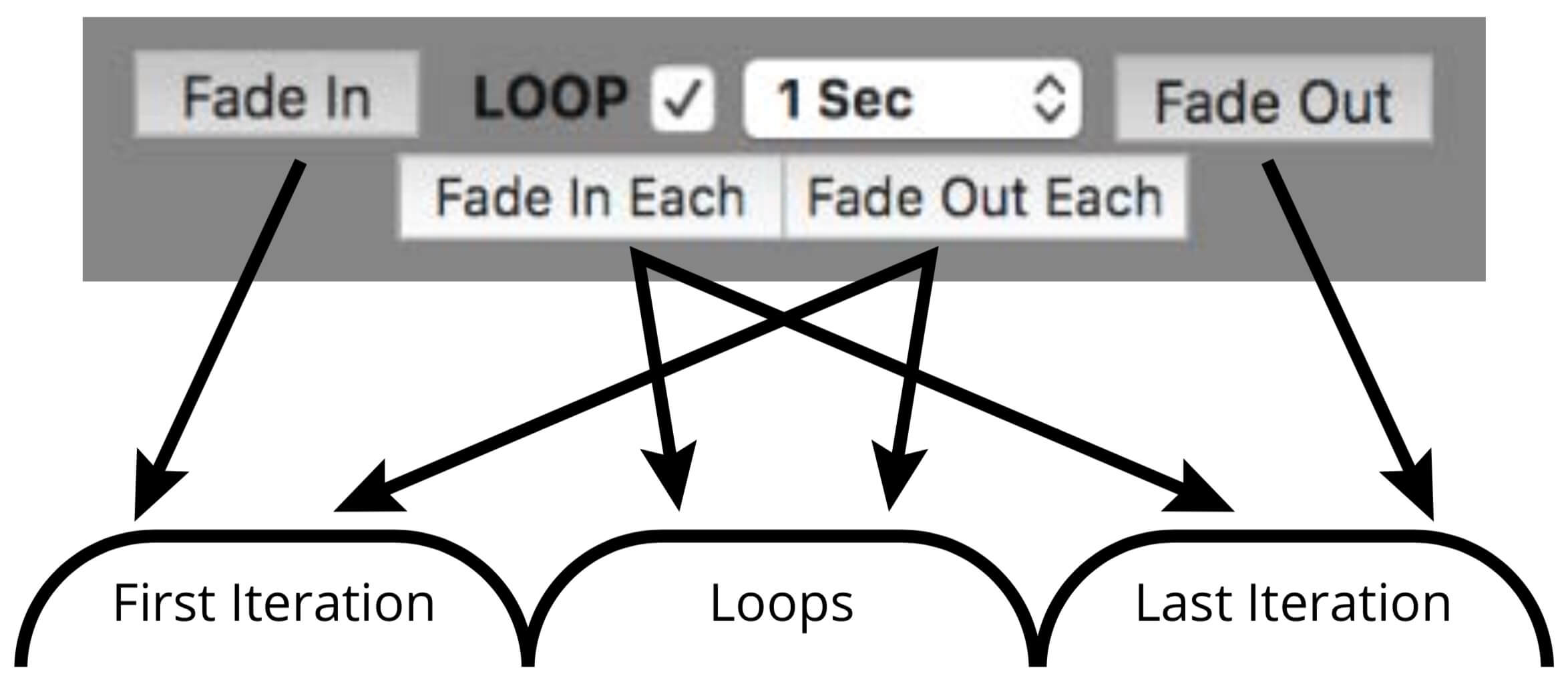

All Keyboard Commands
